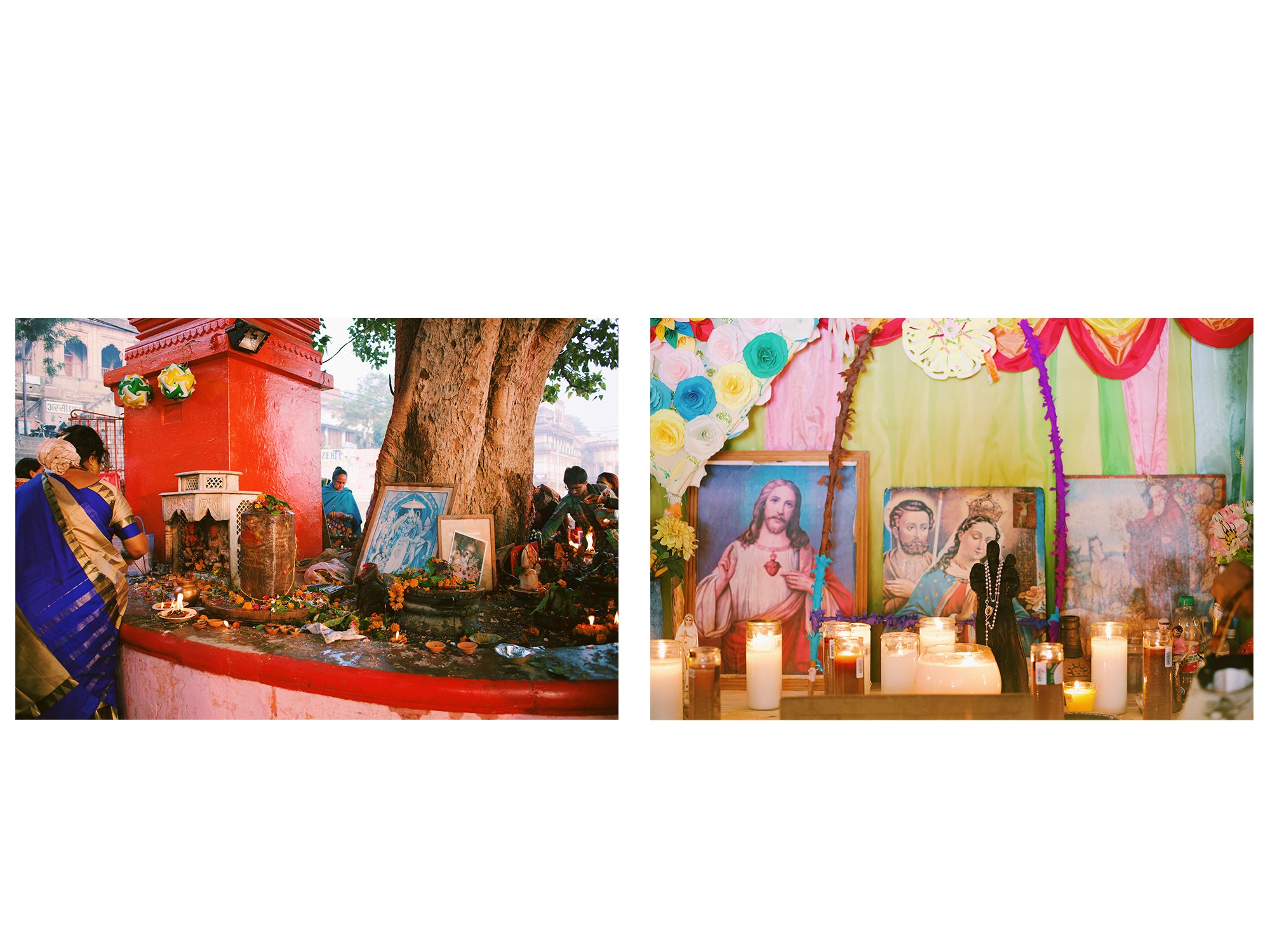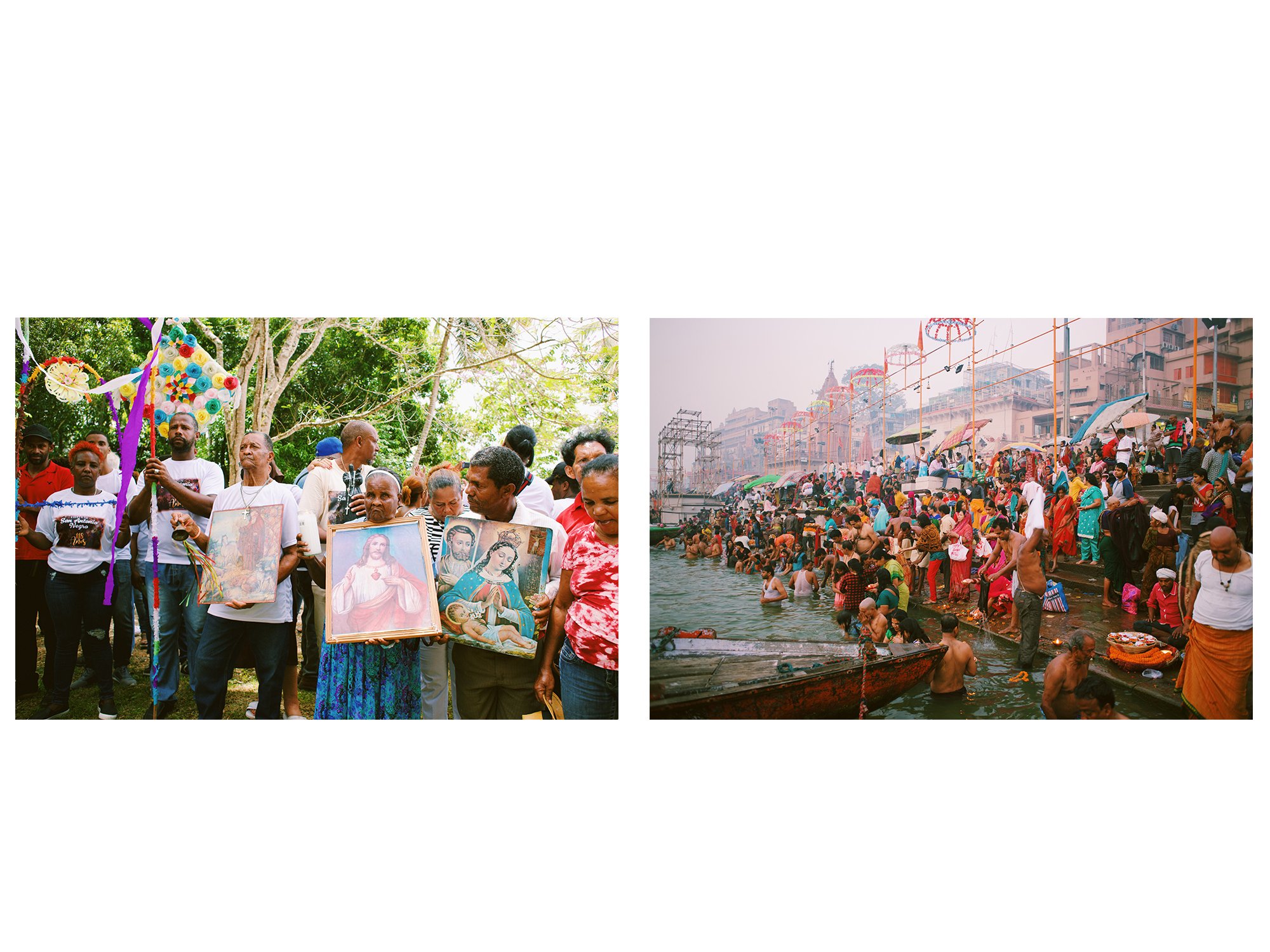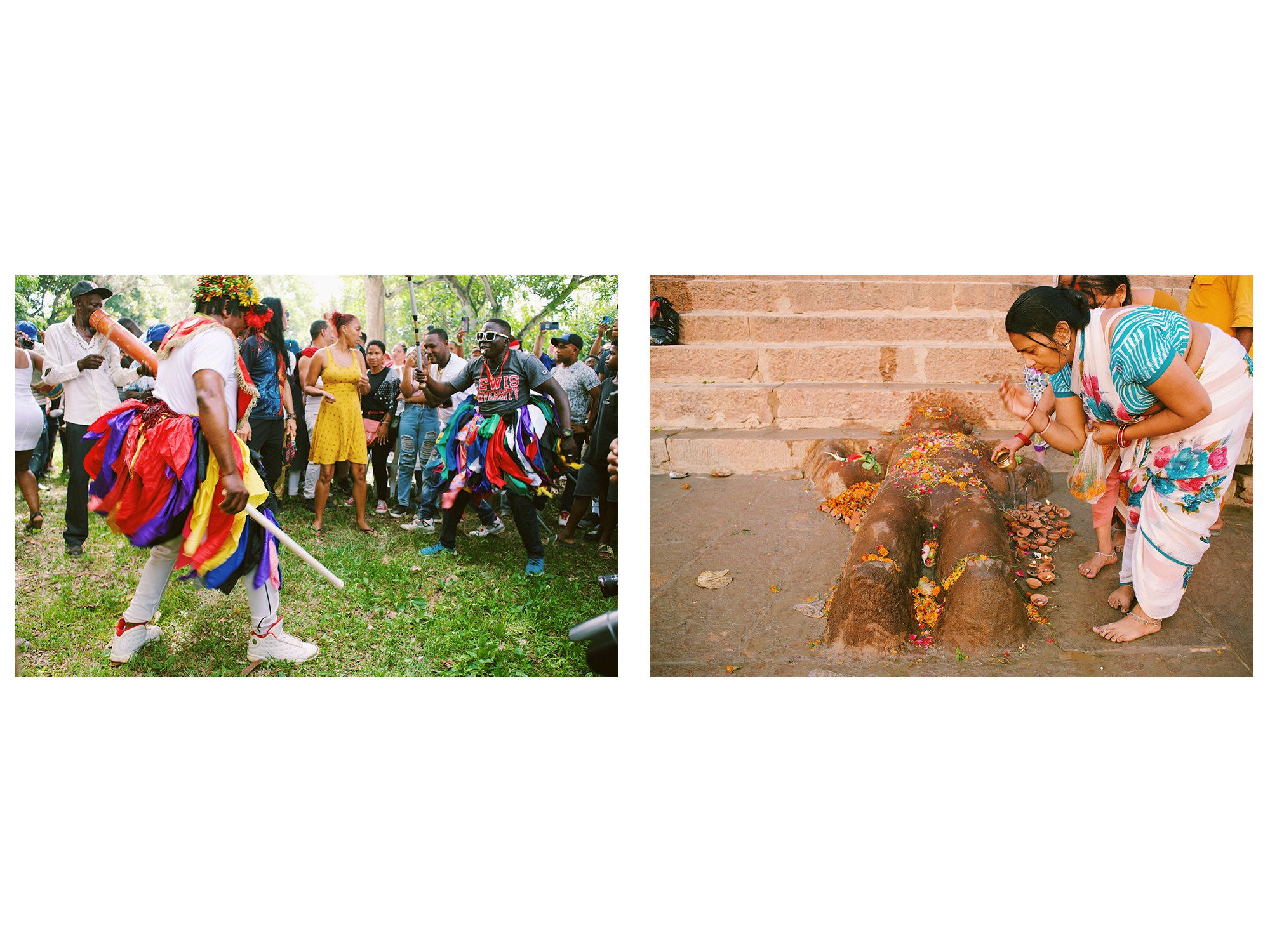de-
votum
-ción
de- from,
votum to vow,
-ción action and effect.
Dashain: Tika-Hands, mixed media, (2020)
De- votum -ción
(2016 - ongoing) is the photographic project that delves into the concept of human devotion and its significance in overcoming the existential challenges of life, while also highlighting the unifying power it holds amidst diverse cultures.
The series captures religious devotees from various faiths, including Hinduism, Sikhism, Islamism, and Christianity, as they express their worship through tangible acts of devotion. These practices involve vibrant colors, culturally significant objects, and diverse textile patterns, all intricately woven into religious rituals, prayers, and festive celebrations. The project highlights the distinctive customs and practices that arise from different cultural standards within these religious beliefs.
The initial photographs were taken in Logan, Utah, in 2017, where the documented devotees exemplify their unwavering attachment to their culture and express their beliefs in every aspect of their everyday lives. Being situated in a state known for its low religious diversity, with the majority of its population identifying as part of "The Church of Jesus Christ of Latter-day Saints," these practitioners of other beliefs find themselves as minority groups.
The other part of the artworks of De- votum -ción were created by merging the original photographs taken in Utah with documentary work from India, Peru, and the Dominican Republic. Part of the visuals incorporates a mixed-media technique, where digital patterns designed from extracted squares of unedited photographs are integrated, forming Diaz Adam’s distinctive artistic signature.
Through De- votum -ción, the artist invites viewers to contemplate the profound human need for devotion, emphasizing its capacity to transcend differences and forge connections among individuals across diverse cultures and religious beliefs.



Dastār Hue-4, Sikh devotee, (2020)
Dastār Hues, (2020)
dastār Hues
Dastār Hues: is an artwork series that explores the profound significance of the Dastār, the turban worn by Sikh men, as more than just a tightly wrapped piece of cotton fabric. It serves as a powerful symbol and tangible expression of Sikh identity. Among the five articles of faith that Sikhs uphold, the Kesh mandates the keeping of uncut hair, which is then wrapped in the Dastār. With roots tracing back to the early days of Sikhism, the Dastār represents a transformative shift toward a new way of life, challenging existing class inequalities. It also carries a poignant commemoration of the times when Sikhs faced persecution due to their turban and unshorn hair. Today, the Dastār stands as a symbol of pride, identity, revolution, and style.
Within the series, Arshdeep, a Sikh devotee of Punjabi origin, is photographed, offering a glimpse into his daily routine and decision-making process as he selects the color of the turban to wear for the day, skillfully coordinating it with his attire. The colors of the Dastār do not hold specific religious meanings, and the styles and types could vary, reflecting the diverse expressions of Sikh identity.
Dastār Hues contemplates the multifaceted nature of the Dastār and its significance within Sikh culture. It celebrates the rich history, resilience, and individuality expressed through the choice of colors and styles, showcasing the pride and identity that Sikhs derive from their turbans. The series aims to deepen understanding and appreciation for the profound symbolism and personal journey that each Dastār represents, beyond its physical appearance.
Altar del Día de los Muertos al padre de Cirina, Christian-Catholic devotee, mixed media, (2020)
Cirina, mixed media, (2020)
Altar del Día de los Muertos al padre de Cirina
Altar del Día de los Muertos al padre de Cirina: explores the colorful and profound celebration of Día de los Muertos, or Day of the Dead, in Mexico. While death is often viewed as a somber aspect of life, this vibrant celebration is a living expression that beautifully combines indigenous traditions with Christian-Catholic feasts.
Rooted in pre-Hispanic beliefs, the celebration considers the departed as continuing members of the community. The focal point of this commemoration is the altar, meticulously created by devotees in their homes or at cemeteries. These altars are adorned with offerings intended to welcome the spirits back into the realm of the living. Among these offerings are iconic Calaveras, intricately painted skulls, as well as water, food, Pan de Muerto (bread of the dead), Papel Picado (artisanal stacked colored tissue paper), flowers, and photographs of the deceased to whom the altar is devoted.
Within this series, Cirina, a Catholic devotee of Mexican origin, is photographed with her face adorned in the traditional Calavera Catrina makeup. This festive attire forms an integral part of the Día de los Muertos celebration. Cirina's altar is a testament of her deep devotion to her deceased father, created with love and reverence.
Through Altar del Día de los Muertos al padre de Cirina, the series embrace the vibrant traditions of Día de los Muertos, fostering an appreciation for the blend of indigenous heritage and Christian influences while honoring the memories of loved ones who have departed.
Dashain Tika, Hindu devotee, mixed media, (2020)
Tika, digital textile pattern, mixed media, (2020)
Dashain Tika
Dashain Tika: is an artwork series that delves into the vibrant celebration of Dashain, also known as Bada'dashain, in Nepal. This festival embodies the manifestation of the Hindu Goddess Durga and stands as the most significant festival in the country. Spanning 15 days, Dashain is a time of worship and rejoicing, symbolizing the victory of justice over evil.
Throughout the festival, each day holds its unique rituals and forms of worship. The tenth day has particular importance as devotees receive Tika from their elder relatives. On this occasion, red tika—a mixture of uncooked rice grains, curd, and vermilion powder—is applied to individuals' foreheads, symbolizing blessings from Navaradurga, the sources of power. Additionally, jamara, barley seedlings, are placed on their heads, representing divine blessings and prosperity. The size of the Tika corresponds to the magnitude of the blessings bestowed.
Within the series, Nirdosh, a Hindu devotee of Nepali origin, is photographed wearing a Dhaka Topi, a traditional hat that holds great significance in Nepali male identity. This emblematic headgear adds depth to his portrayal, reflecting a cherished part of the cultural heritage.
Dashain Tika immerses in the vivid festivities of Dashain, exploring the profound symbolism and rituals that highlight the triumph of good over evil. The series captures the essence of devotion and celebration, aiming to appreciate the rich tapestry of Nepali culture and the significance of Dashain in the lives of its people.
24:31 (left), inter-subjectivity (right), Muslim devotees, mixed media, (2020)
inter-subjectivity_11, mixed media, (2020)
24:31 + Inter-subjectivity
The artworks "24:31" and "Inter-subjectivity" are part of the series The Gaze upon Gendered Islamophobia, as well as De- votum -cion, where the artist delves into the intersectionality of perspectives, interpretations, and circumstances within the context of Muslim women devotee. In De- votum -cion, the focus is on exploring devotional practices within Islam, while The Gaze upon Gendered Islamophobia addresses and expands on the social issue of hijab banning and enforcement in societies. The series aims to contemplate the diverse interpretations and challenges surrounding Muslim women's devotion and experiences.
24:31: draws inspiration from Surah 24 An-Nur, Ayat 31, which addresses the concept of modesty in Muslim women as expressed in the Quran. The artwork documents the act of Sujud, the prostration to God during formal prayer, without taking a specific stance on how this subject should be perceived. It highlights the significance of Sujud, one of the pillars of daily prayers in Islam, performed at specific times throughout the day. Fatimah, a Muslim devotee of Saudi Arabian origin, is photographed wearing a blue floral Jilbab while performing Salah on her green prayer rug, facing the Kaaba.
In contrast, Inter-subjectivity: explores the meeting point between objective reality and subjective beliefs. It delves into the capacity of a concept, such as a prayer, to be observed and communicated among individuals with diverse perspectives. The artwork focuses on the act of prayer, the Salah, shared by multiple conscious minds but influenced and interpreted uniquely by each individual's devotion. The prayer rug symbolizes the everyday life of Muslims, serving as a bridge between their physical space and intangible divine beliefs. The variety of designs and colors seen within the prayer rugs reflect the personalization and value attached to this object in practicing their faith.
Together, these artworks delve into the complexity of Muslim women's devotion and experiences. They highlight the diverse interpretations, perspectives, and personal connections individuals bring to their religious practices, inviting viewers to contemplate the rich tapestry of the Muslim faith and the multiplicity of narratives within it.
Imaged and Imagined a Hundred Times, Hindu devotee, mixed media, (2020)
Imaged-Mandir, digital textile pattern, (2020)
Imaged and Imagined a Hundred Times
Imaged and Imagined a Hundred Times: is an artwork series that delves into the profound role of imagination and imagery within Hinduism, particularly in the worship and devotion of the numerous deities that comprise the Hindu ideology.
In Hinduism, the construction and veneration of sacred images are deeply intertwined with the power of imagination and the ritual of visualization. These images are interpreted and receive ritual offerings, reflecting the importance of imagining them as living entities. For Hindu devotees, the worship of deity images is an integral part of their daily religious life. These images hold a sense of reality because devotees visualize them as such, and their rituals are closely associated with the act of visualizing and worshiping the divine forms. In this religious ideology, imagination is elevated to another level, where it is not perceived as a lack of reality but rather as a creative state that facilitates the rediscovery of a deeper reality.
Imaged and Imagined a Hundred Times aims to explore the role of imagery in the devotional Hindu experience as a transformative instrument. Through this series, there is a recognition of a greater reality that transcends the known perceived values. The artworks were inspired by my personal interpretation of the devotional essence I experienced during independent visual research conducted in India. In the main artwork, Sanju, an Indian devotee, is photographed while worshiping at his small Hindu prayer altar. His photograph serves as a representation of the deep devotion and spiritual connection that believers find in their day-to-day religious lives.
Imaged and Imagined a Hundred Times: invites us to contemplate the profound interplay between imagination, imagery, and devotion within Hinduism. It offers a glimpse into the transformative power of the creative mind and the ability to access a deeper reality through the visual and devotional practices of this ancient religion.










